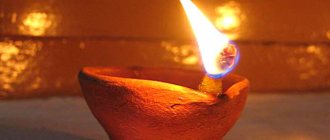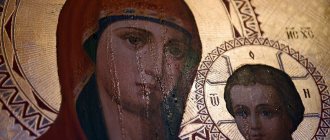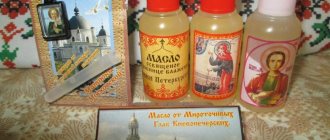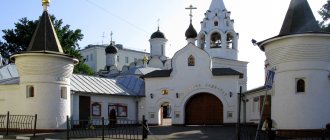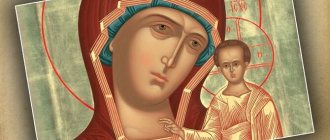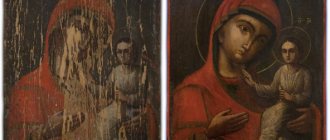Saint Nicholas the Wonderworker is world famous and revered by all Christians. He lived in the 4th century, but even today he remains dear and beloved to many people, because he continues to hear our prayers, help those who turn to him, save them from death, poverty, melancholy and many troubles. Over many centuries, people have found many names for him: St. Nicholas the Pleasant, St. Nicholas the Wonderworker, St. Nicholas of Myra - all this is one saint. His full name, title and name of the rank of saints sound like this: St. Nicholas, Archbishop of Myra of Lycia, Wonderworker. He ruled the diocese of the city of Myra Lycian in Asia Minor and took part in the First Ecumenical Council.
Saint Nicholas the Wonderworker, Bishop of Myra
The saint was born in the 3rd century on the territory of modern Turkey. As a teenager, he began serving in the church. Deciding to devote his life to the Church and all those in need, he devoted a lot of time to study, became a priest, and over time people asked him to be the archbishop of the city of Myra in Lycia. After the death of his wealthy parents, the saint donated his inheritance to the needs of the poor, helping with material means or through his intercession. He was a kind father to all the townspeople. Meekness helped the saint win the love of the people during his lifetime. Being an ardent man, he also strongly denounced the wicked and heretics - so much so that he once struck a blasphemer. Other bishops subjected him to church trial, but the Lord Himself appeared to them and said that Saint Nicholas was pure, and it was not in vain that he punished the wicked.
After his death, Saint Nicholas became so famous for his miracles through prayers to him that he received the name Wonderworker. Miracles from him multiplied, according to his admirers, like the sand of the sea: over many centuries, people witnessed countless signs from God through prayers to the saint.
What is Miro?
Immediately after he departed to the Lord, his body began to exude myrrh - a miraculous liquid that comes only from miraculous icons and holy relics. Soon he was canonized. The remains and bodies of saints are called holy relics.
The relics of St. Nicholas the Pleasant were in his hometown, in a church in his honor, and in 1087, Italian merchants from the city of Bari deceitfully took the holy relics and took them to Italy. Here they are in a white marble closed sarcophagus in the basilica in honor of St. Nicholas. Many pilgrims from all over the world come here every day.
The relics of St. Nicholas the Wonderworker are still located in the Italian city of Bari. Through prayers, miracles are performed before them, which are officially recorded by the Church.
The relics constantly exude myrrh, stream myrrh. Miro is a wonderful fragrant liquid, the exact composition of which scientists still cannot name. The myrrh exudes miraculous icons and the relics of some saints especially blessed by God. This substance is a fragrant oil, and it contains the essential oils of unknown plants, as if unearthly.
For many centuries, evidence of miracles through prayers to the saint was passed on from mouth to mouth, then recorded and now officially recorded by the Church. When the saint’s rib was brought to Russia in 2022, removed for the first time in 900 years from his tomb, many miracles also began to occur, which are recorded in a special chronicle. Many people came to Russia specifically to venerate St. Nicholas, venerate his rib and ask for help in changing their lives.
There are small, even tiny particles of the saint’s relics in some churches in Russia. Many miracles are performed even on small particles of the saint’s relics. However, only the relics of St. Nicholas exude myrrh, which are located in Italy, in the city of Bari.
Sacrament of Confirmation
The Holy Fathers trace the origin of the sacrament back to the time of the Apostles, when the Holy Spirit was transmitted to those who believed and received Baptism, when the Lord’s disciples laid hands on them. When the Church began to multiply in number, the practice of transmitting Grace through consecrated fragrant oil arose, because not everyone could come to the Apostle or Bishop due to the distance. Apparently, the words spoken by the clergyman during anointing also go back to antiquity: “The seal of the gift of the Holy Spirit. Amen"
Now the sacrament is carried out, according to Apostolic practice, immediately after Baptism. The priest does this. But the ointment itself is consecrated only by the Primate of the Church.
In Russia, this has been happening since the 15th century, when the Russian Church became independent from the Patriarchate of Constantinople.
Until the 2nd quarter of the 17th century. Bishops could also conduct peace making. The ban on performing this rite was introduced for them only by the Local Council in 1675.
From that time on, peacemaking took place:
- until the 1st quarter of the 18th century. – Patriarch, then locum tenens of the patriarchal throne in the Three Hierarchs Church of the Kremlin;
- from 1763 to 1917 - in the Cross Chamber of the Kremlin; in addition, metropolitan of the oldest department, Kyiv, in the Kiev-Pechersk Lavra.
- After the restoration of the patriarchate (1917), the consecration took place only in the capital, in the Small Cathedral of the Donskoy Monastery.
From the 5th century A tradition has developed to bless the chrism at the liturgy of Thursday of Holy Week. And the making of the world itself takes up the previous three days of Holy Week:
- on Monday a prayer service is served, after which the primate uses a trikiri to light the wood under the cauldron, where the components of the future shrine are already located;
- Previously, up to 75 of them were used; Now the ritual is carried out according to the order of the 19th century, according to which 30 ingredients are used.
For another two days, the myrrh is continuously boiled over low heat, while the priests read the Gospel day and night.
Useful materials
On the fourth day of Passion, when the Secret Fan is remembered, the primate consecrates the myrrh in the Cathedral of Christ the Savior. At the same time, a few drops of alabaster stored on the throne are added to all vessels. It contains myrrh, consecrated earlier, even many centuries ago. In turn, a small part of the newly consecrated shrine also falls into the alavaster.
The rite is performed every 2-3 years, as needed. The most recent Peacemaking took place from April 22 to April 24, 2019.
Myrrh-streaming of relics
In the history of Christianity, there are also many cases of the appearance of a world not made by hands. It can take the form of not only oil, but also blood and water. Among the honest remains of the saints of God, glorified by this miracle, the most famous relics are:
St. Nicholas of Myra; in modern times, the cancer was opened during the renovation of the basilica in 1953; at the same time, according to the conclusion of Professor L. Martino, “at the bottom of the sarcophagus there was up to 2 cm of transparent liquid, similar to the water of a mountain spring”;
Vmch. Demetrius of Thessalonica; there is evidence of myrrh streaming from the 11th to the 15th centuries; the miracle ceased in 1493, after the basilica where the relics reside became a mosque;
St. Nile the Myrrh-Streaming, monk from Athos (XVII century).
Scientists have repeatedly (including with the blessing of the clergy) tried to conduct an examination of the composition of the miraculous world. Here is what professor, geochemist, petrographer P.V. Florensky, head of the expert group of the Holy Synod, says about this:
“The commission deals with those cases where this phenomenon formally does not depend on a person... But we still cannot analyze and do anything. Why? But because science is not designed for miracles. These are simply different, non-overlapping spheres... We know that we are doing a holy work, cataloging all events. This is our real business. When all these analyzes and so on begin, we treat ourselves very ironically.”
Scientists have still not been able to establish the origin of the world.
Nard oil from Jerusalem
Nard is a flower that grows high in the Himalayas, at an altitude of 3000 m above sea level. Since ancient times, the oil made from its roots has been considered one of the most expensive incense in the East. From the Gospel we know about a woman who poured it on the head of Christ, which extremely shocked some of His disciples, who “were indignant and said to each other: why this waste of peace? For it could have been sold for more than three hundred denarii and given to the poor” (Mark 14:3-9).
Nowadays in Jerusalem they prepare spikenard myrrh, to which they add oil from the lamps burning over the Holy Sepulcher and other shrines.
This oil is usually used by anointing painful areas of the body, or just the forehead, in a cross shape. In this case, one should keep in mind the peculiarity of backgammon, which nun Elizaveta (Senchukova) speaks about:
“Nard is very aromatic. The smell from it lasts for many years. A decade and a half ago, I brought a small plastic bottle of diluted oil from Jerusalem. This bottle itself emitted a fragrant smell, even wrapped in two bags.
Last year I decided that I needed to spend this little jewel on a good deed - and gave it to the temple to decorate the Shroud. The temple was “filled with the fragrance of the world” (John 12:3). The Shroud was fragrant, the hands of the priests were fragrant, the lips of the parishioners were fragrant as they touched the image. The smell was almost intrusive, it made my head spin. It was clear why this incense is used for embalming bodies - having accidentally fallen on your hands on Good Friday, it was not washed off by any means for almost a week.”
How to use the miraculous myrrh from the relics of St. Nicholas the Wonderworker
The tomb of St. Nicholas is filled with fragrant myrrh. According to tradition, the priest takes a small amount of myrrh from the sarcophagus and mixes it with holy water. Then the resulting miraculous liquid is poured into special glass bottles with the icon of St. Nicholas and distributed to pilgrims.
After using the holy world, many miracles are performed. Most often it is used during illness, in difficult circumstances.
- You can anoint your forehead crosswise with myrrh using your finger, a cotton swab or a brush - for example, during an illness or when blessing a person for an important matter, on a journey, or in times of danger.
- You can add myrrh to your drink, especially for sick people who find it difficult to eat.
- Add a few drops of myrrh to food. This is what they do with people who do not believe in the power of the shrine and react aggressively to prayers and offers to turn to God.
It’s okay if the myrrh you purchased sits for a long time and is not used, and then you suddenly need a large amount of holy liquid. Miro does not deteriorate, and there are no restrictions on the amount of its use.
Do not forget that you need to use myrrh with faith and prayer, and not as some kind of folk remedy. You can read the prayer to St. Nicholas for health and healing online using the text below
“Oh Saint Nicholas, great saint of the Lord, our intercessor with your warm prayers before Him, a quick helper in sorrows! Help me, a sinful, sick and despondent person in my life, pray to the Lord that He will give me forgiveness of my sins and mistakes made by me from my youth to this day in deed, words, thoughts and evil wishes, with all my feelings. Deliver me from illnesses and infirmities of soul and body! May the Lord delay the hour of my death! When the time comes for me to leave this world, ask Christ the Savior for a quiet death for me, deliverance from demonic obstacles and ordeals, and the sorrows of hell, but that in heaven, talking with you, I will glorify the Lord our God, Father, and Son, and Always the Holy Spirit. Amen"
Miro (“manna”) from the relics of St. Nicholas
Stone with the Greek inscription “Myrrh-streaming relics of St. Humble Nicholas.” |
The myrrh of St. Nicholas the Wonderworker is an ideally pure liquid, which has been miraculously exuded by his holy relics for many centuries. Back in 1087, when citizens of the city of Bari came to Myra Lycia for the relics of the Saint, they were amazed to see that the tomb with his relics was filled to the brim with a fragrant ointment in which the relics were immersed. And since then, once a year, on the holiday in honor of the arrival of the relics of St. Nicholas in the Italian city of Bari, the rector of the Basilica of St. Nicholas in Bari collects a small amount of this holy liquid from the holy relics. Then the myrrh is added to holy water and poured into special bottles with the image of St. Nicholas. It is impossible to count how many miracles happened after the anointing with this holy world! How many healings there were, how many prayer requests were fulfilled! Having anointed with this world, people seem to venerate the honest relics of the great saint!
|
Here is what the modern Orthodox researcher, Doctor of Historical Sciences Mikhail Talalay, writes: “Pilgrims strive for the shrine of St. Nicholas and for the sake of the miraculous world, or “manna,” as Catholics call it. In Bari, a pious custom arose of pouring myrrh into bottles and then distributing them to pilgrims arriving in Bari from all over. During the last examination of the relics in 1953, those present noticed that all the bones had drop-shaped secretions of the world, and at the bottom of the shrine it had accumulated to a height of three centimeters. The liquid was, as it is now, when myrrh is drawn from a newly walled shrine, a colorless, odorless liquid. Samples of the world were sent to the Department of General Chemistry of the University of Bari, where the liquid was determined to be pure moisture, free of any salts and, in addition, sterile. For centuries they have been taking out myrrh, and now they are taking it out through a hole in the lid of the crayfish, using special scoops.”
| Vial with holy myrrh from the relics of St. Nicholas the Wonderworker |
For a long time, vials of holy myrrh from the relics of St. Nicholas could only be purchased in Bari, in the Basilica of St. Nicholas. And now, directly from Bari, from the relics of the saint of God Nicholas the Wonderworker, vials with holy liquid were brought to Samara! For help and healing to everyone who turns to St. Nicholas the Wonderworker with prayer. These bubbles are a blessing from St. Nicholas! If you anoint yourself with this world with faith and reverence, the great saint can show his ineffable mercy!
Cases of healing through
prayers to St. Nicholas and with the help of holy myrrh in our days
Tatyana Alekseevna Shchepilova, Samara:
— My grandson Miron (he is four years old) has had festering eyes since the summer. Doctors prescribed drops and antiviral medications. It didn’t help... And this continued for more than three months. Then I decided to try to drop a drop of peace from the relics of St. Nicholas the Wonderworker into my grandson’s eyes. The next day we immediately felt empowered. I started dripping some more, and after three days everything went away. We continued to drip for some time, just in case, and the disease completely went away. Saint Nicholas is the great Wonderworker!
Taisiya Petrovna Guseva , 62 years old, Samara
:
— I was diagnosed with glaucoma at the famous Branchevsky clinic. This, of course, greatly upset me. My confessor, Father Georgy Kozin, blessed me to read an akathist to St. Nicholas every day. And I read the akathist religiously, and then it happened that I spoke to Nikolai Ugodnik as if he were alive. I complained to him about how difficult it was for me, told him how much I didn’t want to go blind... And then one day I heard the answer in my heart: “Drip myrrh!” And long before this incident, I read the following advice in the newspaper “Heal by Faith”: bury a drop of Epiphany water in the sore eye, and I did this for two months. But the diagnosis was still confirmed to me.
And from that day on, I began to bury myrrh from the relics of Nicholas the Ugodnik.
Six months later I went to the hospital for tests. And then a miracle happened! I was diagnosed with glaucoma! Such joy overwhelmed me!... Then I went to my ophthalmologist at the 4th medical unit and told about it. And she, a very attentive doctor, told me: continue to drip as you were dripping. And I’ve still been dripping a drop of myrrh for six months now. One bottle is almost gone. But I have one more bottle in stock. So I won't get lost...
You should drip myrrh twice a day, morning and evening. But now I “save” by dripping holy myrrh only in the evening. And in the morning, as before, I drop a drop of Epiphany water into my eye. In addition, in the morning you are always in a hurry to get to work, and in the evening you have the opportunity to drip myrrh slowly, with prayer.
I told my friend, Vera, about this miracle. On my advice, she also acquired myrrh. And soon she came to thank me! She had no peripheral vision at all, but suddenly it appeared. So Nikolai Ugodnik showed his mercy to her!
Nadezhda Efimovna Romanova , 74 years old, Samara
:
“My leg began to swell very much. I prayed to Nikolai Ugodnik and asked him to help me. And only once, right at work (and I was then working as a salesman at Martenitsa), I anointed my leg in a cross shape with the myrrh from the relics of Nicholas the Ugodnik. I took Miro home and thought: if anything happens, my daughter will need it. I come home, look, and my leg is not swollen at all. I anointed it for three more days, and it completely passed. This is such a miracle.
Irina Aleksandrovna Kuznetsova, 39 years old, Samara:
— A few weeks ago, during the flu epidemic, my 11-year-old daughter Julia fell ill. Neither antipyretic medications nor folk remedies helped bring down the high temperature. The temperature kept rising and reached 39.8°. I was about to call an ambulance, but at the last moment I realized: I have myrrh from the relics of St. Nicholas the Wonderworker! I anointed my girl’s forehead, and within a few minutes the temperature dropped to 39.3°, and after half an hour to 37.4. We calmly waited for the local doctor to arrive and prescribe treatment.
Zoya Sergeevna Levshina ,
62 years old, Samara:
- One day I fell and hit the corner of the bed hard. A large lump formed on my forehead - about a centimeter in size, right in the middle. Because of this lump, even during the anointing, the priests did not know how to anoint my forehead. I walked around with this lump for a year and a half or two.
The lump was not painful, soft to the touch, but some kind of pathogenic liquid accumulated inside it. And who knows what this could lead to. Suddenly, God forbid, a tumor could develop from it. I already thought that I would have to see a doctor to remove it.
And then I read in the Lampada magazine about what miraculous healings come from the holy world of St. Nicholas the Wonderworker. I have been a believer for twenty years now, and I do not need confirmation that the Lord and His saints grant us mercies through prayer. When I was a beginner, the Lord gave me so many miracles to strengthen my faith. And now what I read was just a hint that you could try to cure the lump like this.
Last year in the spring I bought two bottles of peace and began to prayerfully lubricate the bump twice a day. She read the troparion and kontakion to St. Nicholas and anointed him. And the lump began to decrease in size, as if drying out. Now it’s quite small, like a pimple, and it’s still getting smaller. Maybe it will disappear altogether. What a miracle Nikolushka performed!
I also bought a bottle. I also anoint the mole on my neck, and it may not disappear completely, but it has already stopped growing.
There is no doubt, Saint Nicholas helps and will help everyone who reverently, with prayer and faith will be anointed with myrrh from his multi-healing relics.
Tatyana Aleksandrovna Negasheva, 63 years old, Tolyatti:
— Several years ago I was diagnosed with glaucoma. Of course, I was very worried, my eyes began to get tired faster. And as much as I read before, I could no longer read - my eyes began to see poorly.
I read in the Lampada about the holy myrrh from the relics of St. Nicholas the Wonderworker, how it helps with eye diseases, and decided to go to Samara to get it. How I found a store on Radonezhskaya ( now the store has moved to Pushkin Street , 272
) and how Nikolai the Wonderworker sent me home from Samara is a separate story. I arrived in Samara and at the bus station began asking how to find an Orthodox store. I got on the trolleybus, took out my ticket - but it is not valid in Samara. But what’s surprising is that the conductors didn’t take any money from me for the trip both there and back. I got off at the right stop and asked how to get to the Orthodox store. They explain it to me, but I can’t hear well, I didn’t really understand anything and decided to go at random. I walked a little and came up to a five-story building. I just turned my head - and there you were, my gaze looking straight at the “Orthodox Store” sign! That’s how miraculously Saint Nicholas led me to the store!
I bought myrrh and went back. I approach the bus station and hear a voice from the loudspeaker: “A bus is leaving for Togliatti, New City.” I see the bus is standing a few meters away from me. I jumped into it, and two minutes later it left. This is how I got home without waiting, without wasting time.
I began to instill myrrh into both eyes first, then, so that it would last for a long time, only in one eye, which sees weaker. I used the entire bottle and began to notice that I began to read longer. And now I read even longer. Glory to God for His great saints and great gratitude to dear Saint Nicholas the Wonderworker!
Natalya Aleksandrovna Savelyeva ,
30 years old, Samara:
- I experienced the ambulance of St. Nicholas when I had a very bad headache for several days. No pills completely relieved the pain - only minor relief came for a while, and then the headache became even worse. In the evening, coming home from work, she poured holy water into a glass, dropped a drop of myrrh from the relics of St. Nicholas into it, drank it with prayer and went to bed. The next morning I didn’t even remember that I was in pain. The headache has completely gone.
Alexandra Egorovna Gubareva, village. Tovarkovsky Bogoroditsky district, Tula region:
— Dear editors of Blagovest! I want to thank you for sending me the myrrh from the relics of St. Nicholas the Wonderworker. It helps me a lot. I began to drink holy water on an empty stomach, to which I add a drop of holy myrrh, read prayers, and venerate the image of St. Nicholas on the bottle. My legs were very swollen. Soon after I started drinking holy water with a drop of myrrh, I noticed that the swelling had decreased significantly. The sores on the forehead, nose and neck turned white and became less noticeable. I thank God and His saint Nicholas the Wonderworker!
Zoya Nikolaevna Solovyova, Kubinka, Odintsovo district, Moscow region:
Dear editors, I sincerely thank you for the myrrh from the relics of St. Nicholas the Wonderworker that you sent last December!
I got sick during Lent. I was admitted to the hospital and diagnosed with a pinched thoracic nerve. The pain was unbearable: I couldn’t breathe, I couldn’t sit down, I couldn’t lie down. It was very difficult to breathe, the pain was simply terrible. I spent 15 days in the hospital, during which time I received 95 injections. But it didn't get much better. The doctor told me that this illness could last a very long time. I suffered with such pain for a month. But, thank God, Easter has come. I confessed and took communion. I really asked the Lord, the Queen of Heaven and the saints, whom I love very much, to help me survive the night Easter service. Everything went well. And just on Easter I remembered that there was myrrh on my table near the icons. She began to anoint her chest with myrrh. And the pain went away, I didn’t even notice how it happened. I just came to my senses: my chest doesn’t hurt anymore.
For many years I have read the troparion to St. Nicholas every day. I was born on May 22, the day of the transfer of the relics of the Saint from Myra in Lycia to the city of Bari. And my father is named Nikolai, and my late husband is Nikolai. I'm already 85 years old. It is difficult to heal at such years. But the Lord is merciful. Just pray earnestly, ask, and help will come. Try not to sin, don’t judge anyone. And thank the Lord for everything - both good and bad. I know that all bad things are sent for sins. This is how I live. Thank God for everything!
I have been subscribing to “Blagovest” and “Lampada” since they began to be published. I sincerely thank all the editorial staff for such a wonderful newspaper. I read it with love, and when I read it, I give it to the church, to the people, and our Father Nikolai loves “Blagovest” very much. May God bless you all for many years to come!
Mira, I’m ordering a third bottle from you, this time for my eyes - the capillaries have burst.
Raisa, Zhigulevsk, Samara region:
Peace be with you, dear brothers and sisters!
I want to share how miraculously the Lord healed my mother and me through the prayers of St. Nicholas the Wonderworker. We purchased myrrh from the relics of St. Nicholas from Bari - the editors of Blagovest sent it to us by mail. When I received the myrrh, I immediately felt the grace emanating from it. Through prayers to St. Nicholas and with the help of the world, my mother was healed of pain in her side, and I was healed of a nervous breakdown, as if I had taken a strong sedative pill.
I also want to tell you how the murdered warrior Evgeniy Rodionov helped me. It so happened that I was left without sleeping pills for five days (this was even before I received myrrh). And without sleeping pills I can’t sleep at all at night. The first two nights I did not sleep at night, and before the third night, going to bed, I mentally turned to the warrior Eugene: “Help!” After that, I fell asleep and slept peacefully for the remaining three nights, as if I were taking sleeping pills. This is the miracle the Lord performed through the prayers of a righteous warrior!
85 years old, Kubinka, Odintsovo district, Moscow region, writes to us
Christ is among us! Dear Anthony Zhogolev and the entire editorial staff, I sincerely thank you and bow to the ground for your concern for us, sinners and the sick. This is the second time I am writing a letter to you and thank you for sending me the myrrh from the relics of St. Nicholas the Wonderworker.
In 2007, I moved to live with my son in the Moscow region. And I don’t know what it is, climate change or God’s permission, but I had a heart attack in my left eye. Three professors looked at me and said that this happens very rarely and it is impossible to perform the operation, since the capillaries burst. And from then on I saw with only one eye. But my second eye doesn’t see well either; I damaged it when I was seven years old.
And then in October 2016, I forgot what exact date, I woke up at night and couldn’t see anything, some kind of film covered my eyes. I began to wash it and saw a little, my eyelids began to itch very much, but because of the purulent influx I could not see anything. I still had a little peace left, so I started putting it in my eyes. But we are impatient people, we want help right away... Five days passed, there was no help, and I said: I’ll stop dripping. And the inner voice says: don’t quit, you need to drip more. And just then I receive a new bottle from you. I began to bury more, and a miracle happened: I regained my sight, began to see well, and the scales fell from my eyes. Only wounds remained on the eyelids, but they soon healed. My vision has improved.
I went to the doctor and told how I was cured. But she remained silent and prescribed medications: ointment and drops.
I ordered a prayer service at the church. Before instilling the medicine, I crossed my eye three times and read a prayer to St. Nicholas the Pleasant. I buried myrrh and asked the Pleasant of God Nicholas, so that I could see and freely read the Gospel, the Psalter and spiritual literature and walk with my feet into the temple of God.
They say that in our time there are no miracles... At the age of 85, this is already the second healing from the holy world of St. Nicholas, isn’t this a miracle? I thank the Lord and Saint Nicholas for such great mercy. I wish God's help and healing to all those who are sick and grieving. The Lord does not leave us! Only we should be grateful to Him and thank Him for all His mercies. It’s such a grace and help that the myrrh of St. Nicholas heals all illnesses. Just ask Nikolai Ugodnik earnestly, and he will not refuse. Many times I tell everyone about the holy world and give them the newspaper to read. May God grant you all health and long life!
Elena, Samara:
One day I saw in a church shop a bottle of ointment from the relics of St. Nicholas the Wonderworker. Previously, I was healed with oil from the relics of St. Seraphim of Sarov, and now I decided to buy this bottle. I have papillomas, thyroid disease, enough diseases... And so I brought the bottle home. I remembered the order of our unforgettable, now deceased, priest from the Church of the Three Saints, Schema-Archimandrite Nicholas (Feoktistov), and he told us this: do not put your finger in a bottle of holy liquid, but rather take a thin candle, dip it in a bottle with a shrine, a church candle, and smear it sore spots on the body.
I bought a Sretensky candle at the Orthodox exhibition and put it in a bottle of peace. And what? I couldn't hide my disappointment. She even exclaimed: “Well, what kind of myrrh is this? It’s just water here!” And suddenly... at first I couldn’t believe my eyes!.. Suddenly, in the bubble with the world, some incomprehensible processes began to happen right before my eyes. Some kind of whitish dregs suddenly appeared there, and it seemed to rise in a column from the bottom of the bubble to its top... This whitish dregs did not disappear. She stood in the same vial the next day and beyond. And only then did I realize that with my careless words I had offended St. Nicholas the Wonderworker! Then I prayed to him with tears, asking forgiveness for my lack of faith. I bought a second bottle of myrrh in the same church shop, and with prayer, with the same candle, I began to anoint my sores with this myrrh. Of course, there was no turbidity in this bottle. And so I began to pray to Nicholas the Pleasant in the morning: “Help, great saint! After all, God even gave you a special day (Thursday) so that we especially pray to you on this day of the week, won’t you help me cope with my ailments!” - and after that she anointed herself with the world. I won’t say that I was instantly healed, but I continue to smear my sores with this beneficial liquid. And gradually the situation is improving. I believe that Nikolai Ugodnik, through his myrrh, brought from the Italian city of Bari, can help me and everyone who turns to him for help. I saw with my own eyes how this holy myrrh reacted to the word I carelessly said...
Holy Hierarch Father Nicholas, pray to God for us!
Lyubov Polyanskaya, Samara:
I express my gratitude to those who brought myrrh to us in Samara from Italy, from the city of Bari, from the place where the relics of St. Nicholas, the great Wonderworker, rest. I purchased a bottle at the Orthodox store on A.S. Street. Pushkina, 272. My mole became inflamed and broke out. And in normal times, going through the chain of doctors would take a long time. But now, when all the doctors are rushed to fight the virus, this has become even more difficult. I read the akathist to St. Nicholas and used myrrh. The inflammation gradually subsided, broke through, cleared, and healed. Many thanks to those who brought myrrh to us in Samara.
In difficult times, save us all, Lord!
How to purchase myrrh from the relics of St. Nicholas
Miro can be purchased at the Orthodox store on Pushkin Street at the address: Samara, st. Pushkina, 272 (former Korostelev Brothers Street). Tel. (846) 221-09-07 or 8-903-301-09-07. Opening hours: from 10.00 to 20.00, daily, without breaks and weekends.
Come for the holy world!
This ointment can now be sent by mail. To do this, you need to place an order by calling (846) 932-78-06. You can send your application by email to blago [email protected] mail . ru . Remember that the holy myrrh from the relics of St. Nicholas is a great shrine, and it requires careful handling. Therefore, a parcel with a vial of blessed liquid will be sent “first class” for safety. And this costs more. The parcel will be sent by cash on delivery.
For those who need to receive the Holy Chrism as quickly as possible, we offer this method of receiving it by mail.
Make an advance payment - send the money by postal order to the Blagovest editorial office. Send money to the address : 443010 Samara, PO Box 243, editorial office of the Blagovest newspaper, Anton Evgenievich Zhogolev. A bottle of blessed peace will be sent to you immediately after receiving the money transfer, first of all.
You can make an advance payment for the package in peace to a Sberbank card 4276 5400 3092 2664 Tatyana Alekseevna Shchepilova. Please email or call the editorial office with your detailed postal address for sending the peace.
The cost of one bottle of peace in the church shop is 1,550 rubles. Sending one peace bubble by mail costs 2,100 rubles, including postage in Russia. The vial with the blessed liquid will be sent by parcel post (postage cost is included in the amount indicated above). On the postal transfer coupon, indicate your exact address, last name, first name and patronymic and make a note: “Miro”. If you prepay for the cost of 2 or more bottles, please call (846) 932-78-06.
May the holy myrrh from the relics of St. Nicholas the Pleasant from the city of Bari come to your homes and bring with it joy, peace, grace and mercy!
Healing from shrines
Let us also note that myrrh is only one of the holy means of help.
- If you are sick in the morning, on an empty stomach, you should make it a rule to drink holy water and eat part of the prosphora (church unleavened bread with a seal from a cross on the flat top, from which particles are taken out with the names of people remembered; the prosphora will be given to your loved ones or to you when submitting a note “Oh health" for the Liturgy, which also needs to be done for you if you are sick). Holy water can also be added to drinks and food.
Blessed oil from relics or from a lamp is also a shrine. Unlike the valuable world from the relics of St. Nicholas the Wonderworker, it can be purchased in every temple and used in the same way.
Never be afraid of prayer in church, do not hesitate to do something wrong. Place a candle in front of the icons of the Lord, the Mother of God, and St. Nicholas, and submit a note of remembrance for you and your loved ones at the Liturgy. Attend worship services, thanking God for your life, for His help to you, for small daily miracles. Learn about the church Sacraments of Confession and Communion, try to start them sometimes. Strengthen your marriage with a wedding, and bless your child on his life's journey with baptism.
And may St. Nicholas accompany you on all your roads and throughout your life’s journey!
Blessed oil is used in all Orthodox rites. What it is? What is church oil made from, and how to use it correctly? Let's try to understand this topic in detail.
Church oil.
Healing oil from St. Nicholas the Wonderworker.
by Radomir Sun Dec 09, 2022 8:15 pm
Masters have a method for preparing oil for rubbing with a prayer to St. Nicholas the Wonderworker. To do this, take half a glass of olive oil, add to it a teaspoon of fir essential oil and the same amount of spruce oil. You can buy essential oils at the pharmacy. Mix everything and read the following prayer for the oil:
“Oh, Nicholas the All-Holy, saint of the Lord, our eternal intercessor, and our helper everywhere in all troubles. Help me, God’s servant (name), sad and sinful, in this life, ask the Lord to grant me forgiveness of my sins, for I have sinned in deed, in word, in thoughts and with all my feelings. Help me, the accursed one, Holy Wonderworker, ask our Lord for good health, deliver me from torment and ordeal. Amen."
If you are making oil for someone, then let the oil sit for three days in front of the icon of St. Nicholas the Wonderworker, and then give it along with a prayer so that it can be read on the oil three times before use. The oil is used externally, for rubbing, anointing sore spots, and massage. If you make it for yourself, then store the oil behind the icon or next to the holy images.
What is church oil
In various sources you can find the terms: lamp oil, oil, myrrh and myrrh. However, the latter is not a sacred oil, as many believe.
Oil is olive oil. Fragrant oils without a strong odor, such as rose, are added to it. While preparing the oil, the clergyman reads prayers. Mixtures prepared on the relics of saints have the greatest power.
There are several types of church oils. They differ in composition, method of preparation and purpose.
Miro is an oil mixture with fragrant herbs and incense. It can include up to 40 ingredients, one of which will definitely be high-quality oil. The head of the church prepares the ointment. It is cooked for three days. To prevent the oil from catching fire, grape wine is a mandatory component.
Lamp oil is high-quality olive oil, sometimes with added incense.
Myrrh is the resin of trees native to the Arabian Peninsula and Somalia. It has a persistent aroma and spicy taste. Less common is myrrh oil. Has nothing to do with church rituals.
3. When do the annual celebrations in honor of the discovery of the relics take place in Bari?
The best time to visit Bari is from May 7 to 9 , when grandiose celebrations take place to mark the arrival of the relics of St. Nicholas in Bari.
The program of celebrations begins on the evening of May 7, when more than 400 participants in medieval costumes recreate the procession of the arrival of the relics into the city from St. George to the Basilica of St. Nicholas. Hundreds of candles, fiery torches and the incessant ringing of bells - an indescribable spectacle!
Also, during the three days of celebrations, you will have a unique opportunity to attend ceremonial services, see numerous concerts and fireworks.
The use of church oil
In the house, any consecrated oil is stored near the iconostasis. You cannot place it near household items or among cosmetics. Lamp oil is poured into the lamp and placed in front of the icons. This is its only purpose.
Oil is used in church rituals such as baptism, unction, and anointing of important guests.
Miro - most often used during baptism.
If you are sick or have any concerns:
- add a few drops to food;
- anoint your forehead or part of the body that is bothering you in a cross-shaped motion;
- in case you don’t know the prayers, pray in your own words. If the oil is prepared on holy relics, it will be more effective to read prayers turning to the saint on whose relics the ceremony was performed;
- blot a small piece of cloth with oil and apply it to the sore spots. When it becomes unusable, it must be burned.
The most healing oil is the one that is consecrated during litia or unction.
Myrrh oil and resin have many healing properties and are often used in folk medicine and cosmetology.
When asking yourself the question of how to use church consecrated oil, do not forget about the power of faith. This is the only way to get a positive result.
Temples and monasteries carefully protect their shrines: the relics of holy people, icons that work miracles. Some icons, as well as the relics of Orthodox saints, exude myrrh. It is customary to carefully collect it and add it to Vaseline or vegetable oil. Also, drops of lamp oil from unquenchable lamps placed next to the relics and icons are added to the oil compositions.
The collected oil is poured into vessels that anyone can purchase and use for medicinal purposes. With the help of this consecrated oil, the physical condition of the believer improves, and mental anguish and anxiety calms down. The peculiarity of the action of consecrated oil is its rapid and quite powerful healing effect.
Anointing
(Photo from pravoslavie.ru)
How to use Miro correctly
It is rightfully believed that myrrh should be in every home, for it is a universal remedy in both sorrow and joy. Holy oil helps to overcome illnesses, in some cases even in the last stages, when the patient is already indicated for surgery. It can be used either in its pure form, simply adding drops to food and drinks, or as an admixture to healing tinctures, or combined with traditional medicines.
On a more subtle, non-physical plane, Holy Myrrh will also prove to be an indispensable helper. During periods of decline, heavy thoughts, difficult temptations, as well as in any crisis situation, when you need to make an informed decision, but your head is a mess, you can perform a simple home ritual. Dip a cotton swab or soft brush into the oil and cross it across your forehead, asking one of the Christian saints for assistance. This will help ward off unkind thoughts and receive a hint from above.
In any case, for whatever purpose the Holy Chrism is used, the attitude towards it must be appropriate, extremely respectful and reverent.
Oil of oil is a symbol of God's mercy
Olive oil with the addition of aromatic components, called oil, was consecrated through prayer and was actively used for healing since the first centuries of the development of Christianity.
Blessed oil has deep symbolism and is the embodiment of God's mercy, God's grace, and also correlates with the concepts of gracious joy and revival. The apostles used the oil to heal the sick and lepers. The rite of anointing with oil accompanied the process of giving a person a part of the Divine Spirit, which from the moment of sprinkling with oil remained in the soul of the believer unchanged.
The important sacrament of the Blessing of Anointing is also associated with the anointing of a Christian with consecrated oil in the name of God for the purpose of healing and accompanying him in earthly life in a state of being filled with the Holy Spirit. The Blessing of Oil not only healed ailments, but also absolved sins, that is, it brought the Christian into a pure state of grateful service to God. The power of the Blessing of Anointing lay mainly in the accompanying presbyteral prayer.
Regular anointing with consecrated oil outside the scope of the sacrament also heals the body and heals the soul, but does not have a power comparable to the effect of the Blessing of Anointing. Healing with consecrated oil involves the healing effect of the oil itself and its beneficial effects, although the power of the sick person’s prayer and the steadfastness of his faith also play a large role in recovery.
Oil is a symbol of eternal bliss and, together with wine and wheat, is the food given to people by God for life. The abundance of these three products is a sign of God's mercy and granted salvation. And the growing olive tree itself acts as a symbol of God’s righteous man, preparing himself for eternal life and steadily following the covenants.
How to use blessed oil?
The benefit from the use of consecrated oil will be, first of all, for every true believer Christian. The Apostle Paul truly stated that everything goes well for the believer. It is no coincidence that consecrated oil is credited with miraculous powers, but, of course, it is not so much the oil itself that heals, but prayers and the power of faith.
Blessed oil will especially quickly help those who live the life of the Church and do not miss Communion and Confession. After the service, when reading the house of prayer before going to bed, it is advised to anoint yourself with the consecrated oil.
The oil should be applied crosswise from the right side to the left, directly crossing the sore spot. After application, the oil can be rubbed for better absorption. The oil is applied either using a small brush specially purchased for this purpose, or with a candle wick.
What types of blessed oil are there?
Blessed oil can be lamp oil, Vaseline oil, or vegetable oil. The latter is edible. It can be dripped in a small volume onto prosphora, artos, antidor or any food from the table, and then eat the food. When eating consecrated oil, be sure to read the appropriate prayer.
Non-edible consecrated oil is suitable for anointing. Church shops offer both oils consecrated on relics and simply oil compositions for lamps, which are also consecrated. There are strict rules regarding the use of oils in the Church.
So, for example, the oil that was used at the Blessing of Anointing cannot be placed in lamps or mixed with other substances, or poured out. Blessed oil is similar in power to holy water, but it is not suitable for sprinkling houses. This oil heals illnesses when applied to the body, and also invigorates the healthy spirit when anointing the heart and forehead area with a cross every morning.
Oil consecrated on the relics of saints is closely associated with the shrine to which it belongs. Accordingly, the Saint will help in illness, and prayers should be addressed to him. Also suitable for anointing is the prayer “Our Father...” or a prayer appeal to the Mother of God. If you do not know prayers, it is not forbidden to ask for healing in your own words: with due diligence and sincerity, the disease will go away under the influence of the consecrated oil.
Blessing of the oil
(Photo from pravmir.ru)
The meaning of Holy Chrism for the church
Holy Myrrh is a special composition and a special recipe.
This oil is used at the most significant moment in the life of a new Christian. Immediately after a person is baptized, anointing with Myrrh is performed - once and for the rest of his life. This symbolizes his acceptance of the Holy Spirit.
Upon completion of the construction of a new church, the first thing to do is consecrate it with holy oil. The Myrrh is also anointed with a necessary attribute of any liturgy - the cloth covering the altar, or the antimins.
It is also known that anointing was performed on kings who ascended the throne. Therefore, they were also called God's anointed. This ritual was common in Byzantium and Rus'.
The symbolic significance of the World for the church is that it represents the gifts of the Holy Spirit. The numerous aromatic substances included in its composition personify many virtues of a true, sincerely believing Christian.
How to store blessed oil?
Blessed oil is one of the most revered and protected Shrines of Orthodoxy, therefore bottles with oil should be stored in the appropriate place - next to home icons. Oil should not be placed next to medicines, cosmetics, or in refrigerators.
The result of a trip to distant Holy places is often the acquisition of numerous rare and especially healing consecrated oils from the relics. Such unique oils cure illnesses surprisingly quickly, but their volume is not so large that you can distribute the oil to everyone you know and those who are sick.
Diveyevo traditions allow in such cases to prepare a clean bottle, fill it with simple vegetable oil and, through accompanying prayers, consecrate it for donation. Prayers over the prepared composition must certainly include an appeal to the Mother of God, the prayer “Our Father...” and a prayer word to the saint from whose relics your oil is consecrated.
